Carpet moths are a type of common household pest that lives in textiles. The larvae feed on keratin which is found in natural fibres, such as wool. Carpet moths are therefore commonly found in carpets, rugs, and other soft furnishings.
If you think you have a carpet moth infestation, it is important to treat it as quickly as possible to prevent permanent damage being caused to carpets, soft furnishings and clothing.
These moths are often found in the darker areas of your home where they are less likely to be disturbed. They are often behind sofas, along the edge of skirting boards or under furniture such as bookcases.
As a preventative measure, you can regularly vacuum and clean these areas, this will create a less desirable environment for these moths. If you believe that you already have an infestation, follow these simple steps to deal with the problem before it becomes too serious.
Getting Rid of Carpet Moths
Step 1: Identification
The carpet moth, otherwise known as the webbing clothes moth, is incredibly common and is most likely the type of moth that you will find in your home on your carpets and even soft furnishings. The second most common type of carpet moth is the case-bearing clothes moth. Whichever type you find in your home, they can be dealt with in pretty much the exact same way.
Carpet moths are smaller than house moths, with a body that is around 5mm in length and a wingspan of between 14 and 18mm. These moths have a buff colour and the forewings usually have three distinct dots.
The hind wings are smaller and usually lighter in colour. These moths are rarely caught flying and are more likely to be seen hopping around on the floor. It’s unlikely that you’ll see carpet moth eggs as they usually fall into the weave of a carpet. The larvae, however, are around a quarter to half an inch long, have a cream colour and a darker head.
If the infestation is of the case-bearing clothes moth, you might find small white cases, that are similar in appearance to grains of rice. It is from these chrysalises that the moths will hatch.
Step 2: Assessment
Consider using a carpet moth trap to determine how serious the problem is. As moths like the dark, undisturbed areas of your home, working out how many there are and how serious the problem is without a trap is likely to be difficult.
Carpet moth traps use the female pheromones to attract only the active adult male moths. Not only will this help you determine how serious the problem is it will also help to contain the growth of the moth population by removing the males from the breeding cycle.

When it comes to placing the trap, inspect the areas of the carpet that are the ideal breeding ground for carpet moths. Look around the edges of the rooms, under or behind furniture, and behind floor-length curtains. Damaged carpets and other soft furnishings are a tell-tale sign that you’re in the right place.
In bedrooms, be aware of the potential for crossover between carpets and furniture such as wardrobes. A large infestation can move from one area to the other.
Step 3: Cleaning
Carpet moths like dust. Dust is home to human hair, pet hair and skin cells, all of which can contain keratin. Regularly and thoroughly cleaning behind furniture and doors, dusting furniture, and shaking out and airing rugs can help remove carpet moths and larvae that may have been living in the fibres.
After vacuuming, make sure to empty the vacuum cleaner outside into a rubbish bag. Tie the bag as tightly as possible and dispose of it immediately to reduce the risk that any carpet moth eggs or larvae remain in your home.
If carpet moths go undetected for long periods of time, they can multiply out of control and cause serious damage before you are even aware that they are there. In this case, you may benefit from a carpet moth killer kit.
Step 4: Reduce breeding
As mentioned before, using carpet moth traps will help reduce population growth – these traps catch the adult males, removing them from the breeding cycle. If you manage to catch them fast enough, you may be able to stop them from laying eggs in the carpet, therefore limiting potential damage.
It is the larvae that damage clothes and carpets, not the adult moths, and so reducing breeding is of the utmost importance. If the adults manage to mate, the female moths can lay hundreds of eggs in their lifetime.
Carpet moth larvae can live for nearly three years in cooler climates, and they will be eating away at your textiles the entire time. In warmer climates, however, they can reach adulthood in little more than a month.
Regardless of your home climate, it is important to deal with the breeding cycle as quickly as possible to save your carpets and soft furnishings.
Step 5: Eradicating eggs and larvae
The larvae only eat keratin, and so will only eat animal-based fibres. They will not eat cotton and synthetic fabrics unless heavily soiled in food or sweat. Wool carpets, fur throws, rugs, cashmere throws, wool and leather are all the fabrics most at risk.
It is unlikely that you will be able to spot the eggs because of just how tiny they are. You may, however, see some of the larvae before they become adult moths, or see a sticky webbing in the carpet.
After cleaning and hoovering, the best assurance you can have that you have dealt with the problem is by using a moth treatment to kill the eggs and larvae. Using a combination of spray and powder treatments will have an immediate effect, and will leave residual protection for around two weeks. In situations with a serious infestation, you might need to repeat the application multiple times to really deal with the problem.
Step 6: Ongoing maintenance

Human and animal hair, dust, food stains and even sweat will all attract moths to the textiles in your home. To prevent this from becoming a problem again, regular cleaning of even the hard-to-see areas is essential.
All carpets and curtains should be regularly deep cleaned to remove any dust build-up. Even if it isn’t visible, the amount of dust that builds up in a textile over the course of a year can be considerable.
Remove all cushions on the sofa and clean underneath regularly. These areas can quickly collect dirt, especially in homes with children or pets!
Removable covers, curtains and rugs should all be shaken off outside as part of a detailed cleaning regime. This will also give you a little more space to vacuum and apply any special treatments you may need.
Step 7: Monitoring
After dealing with an infestation, it may be worth installing a carpet moth trap to monitor for any future activity. This will also help to break the breeding cycle early if adult moths do return. It can also be worth keeping these traps in place throughout the peak season to look out for their presence should they return.
This might seem like a lot of work to eradicate a carpet moth problem, but it will be worth it in the long run. After all, spending the time and a little bit of money dealing with the problem early can save you the expense of replacing all of your carpets in serious infestations.

Lover of coffee, painting, and all things cute and fluffy. I’m always on the lookout for easier, more gentle ways to tackle awful household chores.






